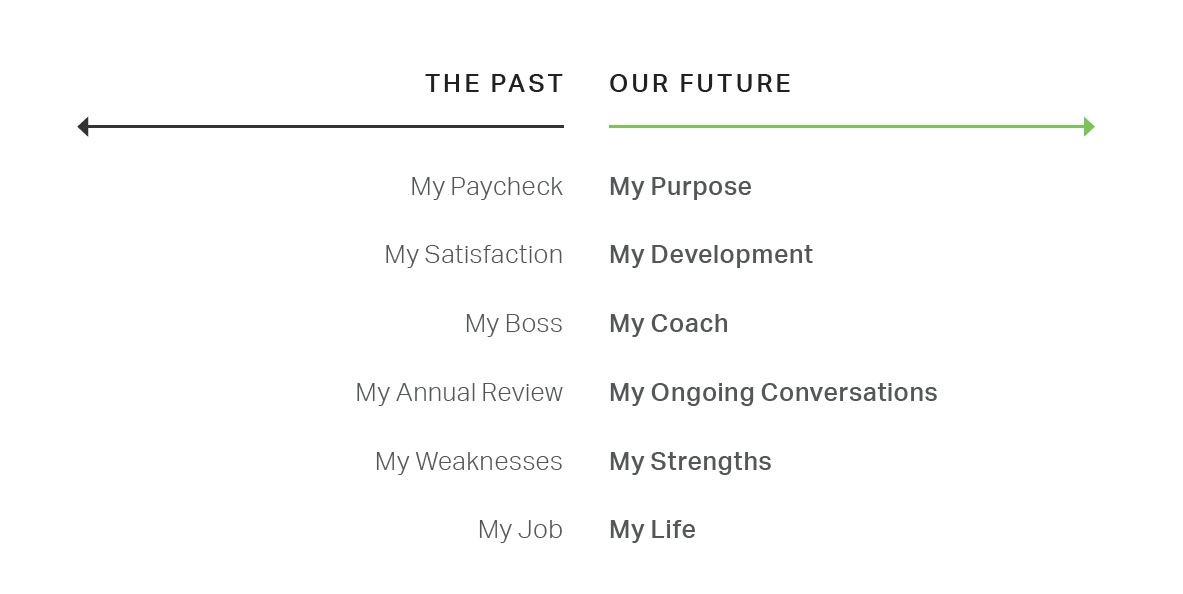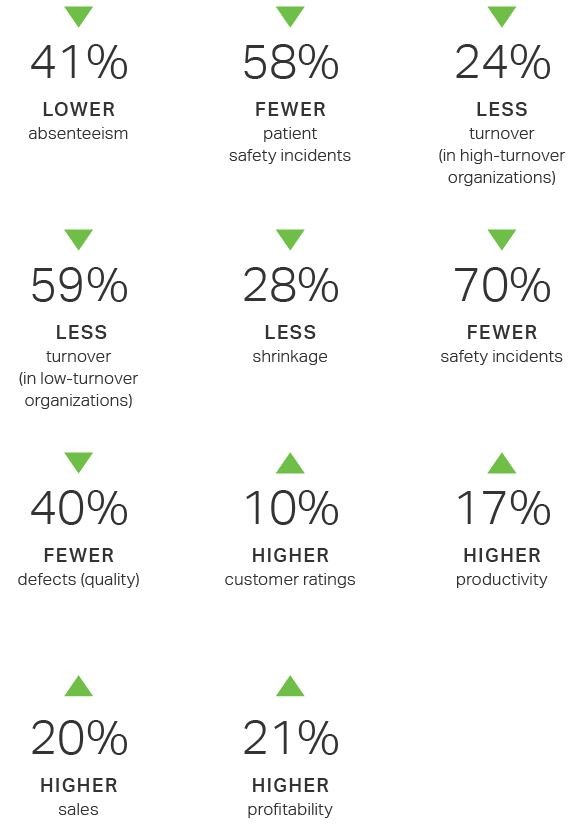Though technology and the workplace are changing, human nature isn’t.
Studies show that the world’s most successful organisations, that have a culture of high employee development are the most productive environment for both businesses and employees.

Employee Engagement and the Changing Workplace
The workplace is changing so fast that it’s hard for many organisations to keep up. Digital technology has changed the way employees interact with each other and their employer.
Teams are now more matrixed, more remote and more flexible than ever before. This has scrambled the traditional worker-manager relationship and has reshaped how employers and employees see one another.
The demands and desires of today’s employees have changed as well. People are looking for more than just a paycheck. They want purpose and meaning from their work. They want to be known for what makes them unique. And they want relationships, particularly with a manager who can coach them to the next level.
From technology to the workforce, all of these changes have made high employee engagement more difficult to achieve. Leaders are asking: What do our employees really need to be successful in their roles? And how do we deliver it in an authentic and consistent way?
Although technology has changed, human nature hasn’t. Employees still have fundamental psychological needs that must be met to achieve high performance. This is as true for independent remote workers as it is for those who work collaboratively in the office.
Engagement remains an essential requirement for producing high-quality work. The organizations that learn to develop a culture of engagement and high performance have a competitive edge, positioning them for success regardless of the changes they encounter.
The Effect of Engagement on Key Business Outcomes
Below see the result of a meta-analysis study on team engagement and performance that includes data accumulated over the past two decades.
When they analysed the differences in performance between engaged and actively disengaged business/work units, those scoring in the top quartile on employee engagement significantly outperformed those in the bottom quartile on these crucial performance outcomes:
Why Most Employee Engagement Programs Haven’t Worked
Data has been collected on business teams around the world for 50 years. Based on that research, 12 statements have been identified that measure key elements of a workplace culture.
These employee engagement factors have been proven to link to performance outcomes across industries, cultures, company size and nationality, and in good economic times and bad.
They work for measuring performance because they describe the fundamental psychological requirements for unleashing human potential.
The world’s greatest leaders and managers intuitively play by these principles. And individual employees, consciously or unconsciously, seek organizations that meet these needs.
Many organisations implement some form of employee engagement program or survey, yet some organisations produce consistently low engagement — even with repeated attempts at boosting their scores.
Other organisations experience initial increases in engagement, followed by a plateau or gradual decline. Leaders at these organisations assume that they have reached the limit for their employees’ engagement or that employee engagement is a fad that cannot be sustained long term.
Finally, there are organisations that think they have high engagement, but their business results tell a different story. They cannot attract strong candidates for open positions.
They lose their best people to competitors. And they see no follow-through on executive initiatives.
At a loss for explanations, leaders may blame the tool; the measurement; the philosophy; or impossible-to-change demographic, cultural or environmental factors that they believe make their problems unique.
But, the apparent failure of employee engagement efforts is likely due to the way engagement programs are executed. For example:
- Leaders make engagement metrics far too complicated by focusing on predictors of their organization’s successes or failures — predictors that often are outside of managers’ control and typically don’t relate to meeting employees’ core psychological needs at work.
- They use a low-bar “percent favourable” metric that inflates scores and creates blind spots, resulting in the appearance of high engagement without strong business outcomes.
- They overuse pulse surveys to get immediate feedback and rarely take action on the results.
In my experience, the greatest cause of engagement program failure is this:
Employee engagement is widely considered “an HR thing.” It is not owned by leaders, expected of managers or understood by front-line employees.
The result is that some organisations believe they have exhausted “engagement” as a performance lever before they truly explore its full potential to change their business. Those that have integrated engagement into their corporate strategy, in contrast, see significant gains year after year.
What the Best Do: The 12 Elements of Employee Engagement
Below are 12 elements of employee engagement that predict high team performance in critical business outcomes including retention, productivity, safety, sales and revenue.
Although the elements may seem elementary, the research has found that a small percentage of employees strongly agree that their employer or manager delivers on them.
The best managers see engagement as one of their primary responsibilities. For these managers, engagement is not merely an annual survey or checklist of tactical action items. They fully integrate the concepts behind each item into casual conversations, meeting agendas, performance evaluations and team goal setting.
In this section, we take a look at each item and explain how the world’s best leaders and managers bring engagement to life for their teams.
Q01 – I know what is expected of me at work.
Helping employees understand what their organization, leaders and manager expect from them requires more than someone telling them what to do. The most effective managers define and discuss the explicit and implicit expectations for each employee. They paint a picture of outstanding performance and help employees recognise how their work leads to the success of their coworkers, their business area and the entire organisation.
Q02 – I have the materials and equipment I need to do my work right.
“Materials and equipment” is not just a checklist of tools. It includes both tangible and intangible resources — office supplies, software, knowledge sharing and permissions, to name a few — that employees need to do their job.
The most effective managers don’t assume what their team needs. They ask for and listen to their employees’ needs and advocate for those needs when necessary. They also find ways to make the most of their team’s ingenuity and talents when they cannot fully fund requests.
Q03 – At work, I have the opportunity to do what I do best every day.
When people get to do what they do best every day at work, the organizations they work for get a boost in employee attraction, engagement and retention.
Successful managers get to know their employees as individuals and give them opportunities to apply the best of their natural selves — their talents. They talk to each employee about their unique value and make adjustments to align work, when possible, with team members’ talents. The best managers know where their employees excel and position them so they are engaged and provide maximum value to the organisation.
Q04 – In the last seven days, I have received recognition or praise for doing good work.
Recognition motivates, provides a sense of accomplishment and makes employees feel valued for the work they do. It also sends a message to other employees about what success looks like.
The most effective leaders create a recognition-rich environment with praise coming from multiple sources at multiple times. The best managers learn how individuals like to be recognised, and they recognise them timely and often for achieving their goals and monstrating high performance. They also explain why their performance matters.
Q05 – My supervisor, or someone at work, seems to care about me as a person.
Few managers take defined action to meet this employee need because caring about someone else cannot be manufactured. But the most successful managers know employees as individuals, acknowledge achievements, have performance conversations, conduct formal reviews and, above all, respect their employees.
These behaviours build a work environment where employees feel safe experimenting with new ideas, sharing information, exploring opportunities for development, and supporting each other in their work and personal lives.
Q06 – There is someone at work who encourages my development.
“Development” doesn’t mean “promotion.” A promotion is a one-time event. Development is a process of understanding each person’s unique talents and strengths and finding roles, positions and projects that allow employees to apply them.
Great managers coach employees by identifying wins and misses, motivating them to go beyond what they think they can do, connecting them with potential mentors, and holding them accountable for their performance.
Q07 – At work, my opinions seem to count.
Asking for and considering individuals’ input leads to more informed decision-making and encourages new ideas that positively influence business results.
The best managers promote open dialogue and provide honest feedback on employees’ opinions and ideas — supporting good ideas and addressing unfeasible ones. Great managers create feedback loops so people feel like they are involved in the decision-making process.
Q08 – The mission or purpose of my organisation makes me feel my job is important.
Employees cannot energize themselves to do all they could do without knowing how their job fits into the grander scheme of things. People want to contribute to a higher purpose, beyond the practical needs of earning a living.
Leaders must ensure that the organization’s mission and purpose are clear and aligned with the employee experience. Managers play a significant role in helping employees understand how their role and daily tasks contribute to the organisation’s mission. Great managers create opportunities for employees to share mission moments and stories about the organisation achieving its purpose.
Q09 – My associates or fellow employees are committed to doing quality work.
As work becomes more interconnected, interdependent and project-based, employees’ shared commitment to quality is vital to an organization. High performers can become resentful when a coworker is not contributing or being held accountable.
Great managers do not stand by and watch their team erode. They establish clear standards of performance, hold employees accountable and foster an environment of excellence by recognizing and sharing examples of exceptional work.
Q10 – I have a best friend at work.
This is the most controversial of the 12 elements, but the truth remains: It predicts performance. When employees have a deep sense of affiliation with their team members, they take positive actions that benefit the business — actions they may not otherwise even consider.
Obviously, managers cannot manufacture friendships, but they can create situations for people to get to know each other and socialise without disrupting performance outcomes.
Q11 – In the last six months, someone (besides my direct manager) at work has talked to me about my progress.
Employees need to know how they are doing, how their work is being perceived and what the future holds. “In the last six months” suggests that employees benefit from more than an annual performance review. When a manager regularly checks in on their employees’ progress, team members are more likely to believe they get paid fairly, more likely to stay with the company and more than twice as likely to recommend the company to others as a great place to work.
Great managers have frequent conversations — formal and informal — with employees about how they are doing. In short, they are coaches, providing immediate, constructive and motivating feedback to help employees achieve increasingly better results.
Q12 – This last year, I have had opportunities at work to learn and grow.
When employees do the same things every day without a chance to learn something new, they rarely stay enthusiastic about their jobs. In contrast, when people feel like they are learning and growing, they work harder and more efficiently.
Successful managers challenge employees, create learning opportunities and frequently ask employees what they are learning. Beyond providing training, they encourage employees to learn new skills or find better ways to do a job. They talk with employees about short-term and long-term growth goals, and they are open to allowing their employees to take on new responsibilities and roles.
The value of these questions comes from their practical application to real workplace issues.

Simply taking an engagement survey once a year will not create meaningful change for an organisation. An employee engagement survey succeeds when it changes the conversations and behaviours of managers and employees in an authentic way.
Workplace culture is complex. There are no quick fixes when it comes to human relationships. But focusing on these fundamental psychological requirements for high performance can make interactions more meaningful and insightful.
In my next article I will provide examples on how these concepts can help address common workplace problems, How to Connect Employee Engagement and the Employee Experience, Employee Lifecycle, What is The Manager’s Role in Employee Engagement, How to Embrace a Culture of High Development Through Engagement and more








